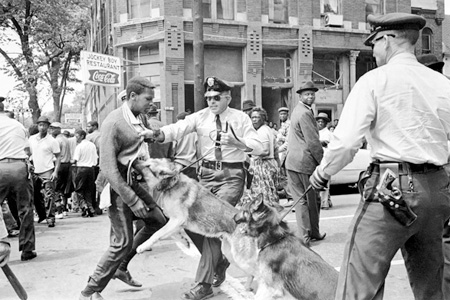
CIVIL RIGHTS DEMONSTRATION–In this May 3, 1963 file photo, a 17-year-old civil rights demonstrator, defying an anti-parade ordinance of Birmingham, Ala., is attacked by a police dog. (AP Photo/Bill Hudson)
by Christopher Sullivan
Associated Press Writer
A new year was just beginning — an extraordinary year, in which so much would change.
Half a century ago, on Jan. 14, 1963, George Wallace took the podium to give his inaugural address as governor of Alabama. His words framed a fiery rejoinder to a civil rights movement gathering strength.
“I draw the line in the dust and toss the gauntlet before the feet of tyranny,” he thundered, “and I say, segregation now, segregation tomorrow, segregation forever!”
Fifty years later, the words still have the power to shock. In college classes like “The Sixties in History and Memory,” today’s students recoil.
But turn the pages of their text to a day just seven months later, and there’s another riveting oration. At the thronged Lincoln Memorial, the Rev. Martin Luther King Jr. offered a vision of a “day when all of God’s children, Black men and white men, Jews and Gentiles, Protestants and Catholics, will be able to join hands and sing in the words of the old Negro spiritual: ‘Free at last! Free at last! Thank God almighty, we are free at last!'”
The students shiver at the words and cadence of this speech — and at the contradictions and convulsions of 1963.
“We constantly make the point,” notes Donald Spivey, who teaches “The Sixties” at the University of Miami, “that you’re hit with all of these things at once.”
What things?
Under the shadow of the Cold War’s threat of “mutually assured destruction,” 1963 was the year of dawning arms control between the U.S. and the Soviet Union; they signed a Nuclear Test Ban Treaty. In June, the adversaries agreed to set up a “hotline” communications link between the Kremlin and the White House to insure against a catastrophic mistake.
For many women, it was a year of liberation. The 1963 best-seller “The Feminine Mystique” catalyzed the modern women’s movement. One author says the book literally saved lives.
Around 1963, the critical mass of the baby boom generation was reaching a critical moment. Its leading edge, teenagers by then, were starting to recognize what they wanted to do, to believe and, significantly, to buy. The music they listened to was beginning to challenge givens of the conformist 1950s. Bob Dylan, who sang in 1963 of all that was “blowin’ in the wind.” Motown. And soon the shaggy-haired, parent-unsettling Beatles, whose first album came out in Britain that year, leading a new wave of Pied Piper bands who’d produce much of the generation’s soundtrack.
At the center of it all was the Kennedy administration, glamorous and youthful, often likened to “Camelot” — the mythical world lasting, as a Broadway lyric lamented, just “one brief, shining moment.”
Then suddenly, in November, the greatest jolt of all in a year of tumult, one felt still today: Rifle shots in Dallas that brought that moment to a close.
___
“So much happened in the ’60s that every year is almost its own brand … and ’63 has a rightful place,” said Jeremy Varon, a history professor at New York’s New School and co-editor of the journal “The Sixties.”
The decade’s themes resounded, he says. There was “the revolution in race relations,” the divisive Vietnam war, widespread experimentation with drugs, the sexual revolution, a societal turn toward youth.
“All of this was experienced as a crisis,” Varon said. But he added, the period was “also exuberantly fun.”
Ever since, “youth has defined popular taste,” and a favored demographic for marketers remains the age group 18-to-35.
“Coming of age in the ’60s still is sort of the great archetype of … what youth is all about,” said Varon, and the decade’s early years helped define that. “Kennedy gave young people this charge to define American strength … and virtue.”
And today’s students appreciate that — even while consigning Kennedy and King to a misty past. Having grown up during the shadowy war on terrorism, many show no sense of “what it’s like to live in a culture of optimism.”
“The biggest thing I find,” Varon added, “is that students are enraptured by the fact that once upon a time young people had a sense of purpose in life.”
Cultural historian Thomas Hine calls the young people of the 1960s “the luckiest generation.”
Their sense of purpose coincided with an economic upswing that had propelled the nation since the end of World War II, with the promise of progress seen in relentless “Mad men”-style advertising — everything “new and improved” — and with Kennedy’s New Frontier.
“The ‘New Frontier’ was really a very shrewd phrase. Westerns were the most popular thing on TV, and the frontier of space was the future,” said Hine, author of “Populuxe,” an examination of ’50s and ’60s ideas.
In a popular cartoon, the Jetsons were part of a community floating above Earth, and yet they relied on updated versions of every terrestrial pushbutton appliance and lived the life of a suburban nuclear family. Media and political messages of the time, Hine said, met in “the idea that the whole world could be managed.” Even amid global jitters and social strains at home, there was “the idea that we can take more control of our lives.”